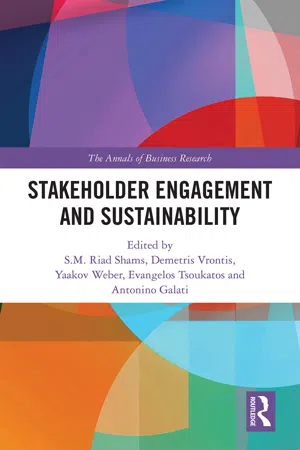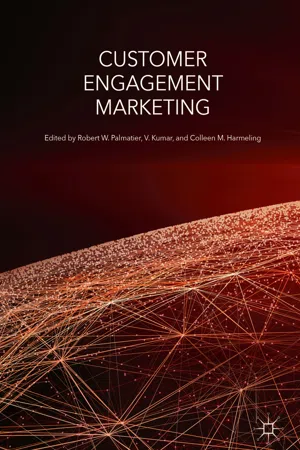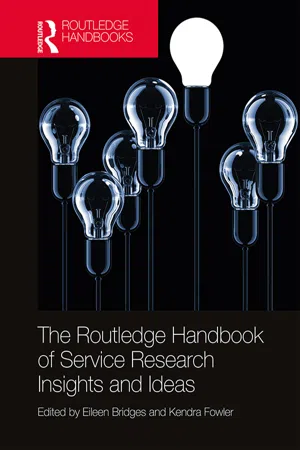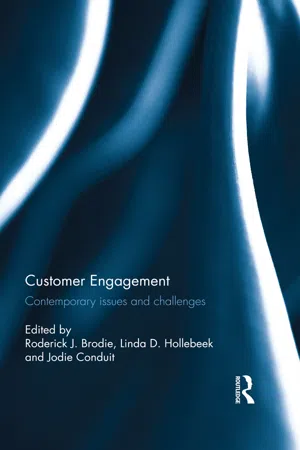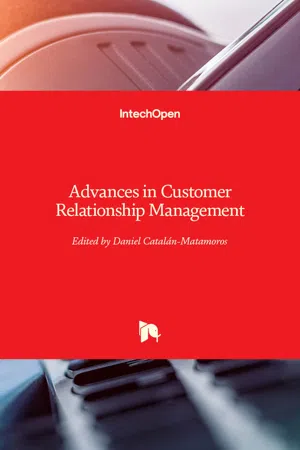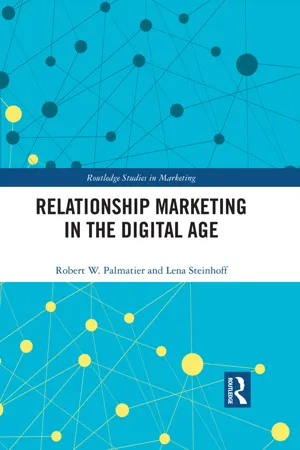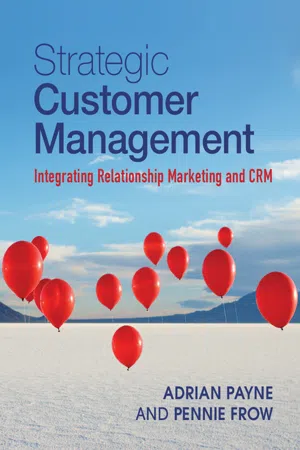Marketing
Customer Engagement
Customer engagement refers to the ongoing interaction and relationship between a customer and a brand. It involves creating meaningful connections through various touchpoints such as social media, email, and in-person interactions. The goal is to build loyalty, trust, and long-term relationships by providing valuable and personalized experiences for customers.
Written by Perlego with AI-assistance
Related key terms
1 of 5
10 Key excerpts on "Customer Engagement"
- eBook - ePub
- S.M.Riad Shams, Demetris Vrontis, Yaakov Weber, Evangelos Tsoukatos, Antonino Galati(Authors)
- 2019(Publication Date)
- Routledge(Publisher)
It has often been noticed that today’s market scenario, technological development and fierce antagonism, in combination with the variety of available products and well-informed consumers, lead organizations to increasingly involve their customers at all possible contact points (Islam and Rahman, 2016). “Customer Engagement” or “consumer engagement” is described as a method to create, build and increase customer relations (Islam and Rahman, 2016). It is considered to have the ability to influence consumer satisfaction, customer loyalty, firm performance and firm value, and therefore, it is receiving increasing attention from scholars and marketing practitioners (Islam and Rahman, 2016).The concept of Customer Engagement has arisen in the marketing discipline and service literature only during the past decade (Brodie et al., 2013). Before the beginning of the study of this term in marketing, other academic disciplines, such as social sciences, management, organizational behavior and psychology, have provided a variety of definitions for engagement forms (Alvarez-Milán et al., 2018; Islam and Rahman, 2016; Brodie et al., 2013). However, the managerial interest in Customer Engagement has started increasing, and it is expected to continue to do so. Specifically, marketing practitioners pay close attention to the correlation between brand equity, sales and earnings from highly engaged consumers (Alvarez-Milán et al., 2018). For example, recent research on this area has indicated that truly engaged customers spend more on their transactions, shop more frequently and are more likely to recommend their brand (Alvarez-Milán et al., 2018). Also, marketing researchers highlight how Customer Engagement has the potential to achieve competitive benefits and create relationships with customers that are not solely based on monetary motives (Christofi et al., 2019a, 2019b; Alvarez-Milán et al., 2018; Christofi et al., 2018; Leonidou et al., 2018). Thus, there is strong evidence to support the ideas that the success of a business depends to a large extent on Customer Engagement, and understanding consumers’ motivations that drive their participation in various contexts can help organizations to unleash this potential (Zhang et al., 2014). - eBook - ePub
- Robert W. Palmatier, V. Kumar, Colleen M. Harmeling, Robert W. Palmatier, V. Kumar, Colleen M. Harmeling(Authors)
- 2017(Publication Date)
- Palgrave Macmillan(Publisher)
Over the years, with the use of social media platforms for marketing activities, marketers realized that it is not enough to only understand how long the customer will stay with the firm but also to understand if there are other ways beyond purchases that customers can contribute to the firm. This led to the rise of the term Customer Engagement in marketing.Consistent with the developments in the marketplace, this book of Customer Engagement Marketing covers a broad range of strategic issues regarding the antecedents and consequences of Customer Engagement. It also focuses on understanding Customer Engagement in different contexts and extending the concept of Customer Engagement. The book comprises 14 chapters which are organized into three parts (see Fig. 1.1 ) consisting of the antecedents, consequences, and the different contexts of Customer Engagement.Fig. 1.1 Organization of the bookHowever, before we dive into the chapters, it is crucial to understand the basic foundation of Customer Engagement by focusing on the following questions:- a) What is Customer Engagement?
- b) What is the theory driving Customer Engagement?
- c) How is it different from other customer relationship management constructs?
- d) Are there any benefits of engaging customers?
- e) Are there situations/contexts where Customer Engagement would be enhanced?
Understanding Customer Engagement
Engagement has been discussed over the past century with various interpretations in numerous contexts. In the context of social welfare, engagement is discussed as civic engagement, social engagement, community engagement, etc. In the business world, it is discussed in a contractual relationship context, and in management, as an organizational activity with the internal stakeholders. In the marketing domain, engagement is associated with the level of an active relationship that a customer shares with a firm and is termed as Customer Engagement (CE).Customer Engagement has been discussed extensively in the past decade in both marketing academia and the business world. It was the eighth most frequently used buzz word in business in 2014. In the business world, it has been considered a strategy, investment, listening to the customer’s voice, emotional connection, and interaction with the organization beyond what is necessary.1 Gallup studies indicate that:- In the consumer electronics industry, fully engaged shoppers make 44% more visits per year and spend $84 more than a disengaged customer.
- Fully engaged shoppers make 44% more visits per year to their preferred retailer than actively disengaged shoppers.
- Eileen Bridges, Kendra Fowler, Eileen Bridges, Kendra Fowler(Authors)
- 2020(Publication Date)
- Routledge(Publisher)
For example, Man-chanda, Packard, and Pattabhiramaiah (2011) reported that customers who joined a brand community increased their online purchases by 37% and their o ffl ine purchases by 9%. However, this relationship needs further investigation to be con fi rmed. Epilogue Social media started as entertainment devices; however, they have evolved into powerful marketing tools. Although their primary purpose was to connect people, social media now play a major role in connecting marketers with customers, and customers with other customers. Moreover, social media enable customers to gather information, actively con-tribute to the creation of new ideas and concepts, while also facilitating and enhancing the relationships developed between a brand and its customers. Marketing via social media is on the rise, because social media have become important in the business world and show great potential for further development (e.g., use of video product presentation and increased sales). Gaining a better understanding of why and how customers engage with brands in social media has become important to fi rms all over the world. Social media customer engage-ment relates to signi fi cant marketing activities, ranging from customer complaint handling to new product development. Yet, despite the substantial investment marketers have made in various forms of social media, many of these communities present low engagement levels. This chapter delves into a large number of possible drivers of social media Customer Engagement and highlights the most important ones. Speci fi cally, it is proposed that cus-tomer intrinsic factors, such as individual and social motives, and extrinsic factors (refer-ence groups) a ff ect Customer Engagement behaviors. Thus, Customer Engagement may a ff ect marketing metrics such as customer satisfaction, trust, loyalty, and value, which sub-sequently should a ff ect fi rm value (e.g. Lehmann 2004).- eBook - ePub
Customer Engagement
Contemporary issues and challenges
- Roderick J. Brodie, Linda D. Hollebeek, Jodie Conduit, Roderick J. Brodie, Linda D. Hollebeek, Jodie Conduit(Authors)
- 2015(Publication Date)
- Routledge(Publisher)
Calder et al., 2009 ).Abdul-Ghani et al. (2010) Engagement Requires consumer connection (e.g. with media), and implies utilitarian, hedonic and social benefits that are the bases of [consumer] engagement with a specific consumer-to-consumer auction site. Vivek et al. (2012) Customer Engagement The intensity of an individual’s participation and connection with the organisation’s offerings and activities initiated by either the customer or the organisation. Higgins and Scholer (2009) EngagementA state of being involved, occupied, fully absorbed or engrossed in something (i.e. sustained attention), generating the consequences of a particular attraction or repulsion force. The more engaged individuals are to approach or repel a target, the more value is added to or subtracted from it.Bowden (2009) Customer EngagementA psychological process that models the underlying mechanisms by which customer loyalty forms for new customers of a service brand, as well as the mechanisms by which loyalty may be maintained for repeat purchase customers of a service brand.Patterson et al. (2006) Customer Engagement The level of a customer’s physical, cognitive and emotional presence in their relationship with a service organisation. Brodie et al. (2011) Customer Engagement A motivational state that occurs by virtue of interactive, co-creative customer experiences with a focal agent/object (e.g. a brand) in focal service relationships.As stated in the Introduction, a multi-stakeholder S-D logic/SET-informed perspective is adopted in this study. Specifically, SET posits, broadly, that customers will reciprocate positive thoughts, feelings and behaviours towards a specific individual (e.g. service employee) or object (e.g. a brand) upon receiving specific benefits from interacting with these (Blau, 1964 ; Pervan et al., 2009 ; Abdul-Ghani et al., 2010 ). Referring to the literature, which cites brands to have specific personalities, analogous to human beings (Aaker, 1997 ; Hosany et al., 2006 ), the SET perspective engenders particular relevance with respect to consumers’ willingness to reciprocate (e.g. by interacting with, or providing positive word-of-mouth regarding, focal brands), thus contributing to these individuals’ engagement with particular objects (Libai, 2011 ; Hollebeek, 2011a ; Van Doorn et al., 2010 ; Sawhney et al., 2005 ; Saks, 2006 - eBook - PDF
- Daniel Catalan-Matamoros(Author)
- 2012(Publication Date)
- IntechOpen(Publisher)
4 Customer Relationship Marketing: Customer-Centric Processes for Engendering Customer-Firm Bonds and Optimizing Long-Term Customer Value Namita Bhatnagar Department of Marketing, I. H. Asper School of Business, University of Manitoba, Winnipeg, Canada 1. Introduction Relationship marketing puts forward that firms’ interactions with a variety of agents are part of an ongoing process (akin to a relationship) as opposed to being discrete transactional events (Morgan & Hunt, 1994). Research within the area has examined interactions with numerous internal and external agents—such as, those that occur internally with employees (e.g., Arndt, 1983), within and across functional areas (e.g., Ruekert & Walker, 1987) and business units (e.g., Porter, 1987), as well as externally with service providers (e.g., Moorman, Zaltman, & Deshpande, 1992), suppliers (e.g., Frazier, Spekman, & O’Neal, 1988), allied companies (e.g., Bucklin & Sengupta, 1993), and customers (Berry, 1983). While a holistic conceptualization of relationship marketing encompasses a network of all relational exchanges relative to a firm (Morgan & Hunt, 1994), a focus on profitable relationships with customers has gained traction as well as undergone transformation in recent years (Kumar & Reinartz, 2006; Thomas, Reinartz, & Kumar 2004). Earlier research, particularly in the domain of services marketing, concerned itself with attracting, developing, and retaining customers as a means to creating customer equity (Berry 1983, p. 25; Berry & Parasuraman 1991, p. 133). Moreover, retaining customers and sustaining long lasting relationships with them was argued as being more beneficial to firms than acquiring new customers (Bendapudi & Berry, 1997). - eBook - PDF
- Andrew MacLaren, Thomas Farrington, Kevin O'Gorman, Andrew MacLaren, Thomas Farrington, Kevin O'Gorman(Authors)
- 2017(Publication Date)
- Goodfellow Publishers(Publisher)
5 Customers Matthew Alexander Introduction Why the concern about relationships in marketing? The word ‘relationship’ is ubiquitous in modern society. Apart from the social relationships we have with family and friends (from distant to extremely intimate), there are a whole range of more spurious relationships which we have (or are told we have) with other focal objects. From politicians to firms to inanimate objects our relationships are central and, seemingly, essential to our modern lives. But it did not always seem this way. This chapter explores the birth, growth and metamorphosis of relationships in marketing. The notion that firms and customers can instigate, develop or break off socio-economic relationships with each other is of vital importance to marketers, but our understanding of the term is constantly evolving. This chapter explores the birth and development of relationship marketing in the latter half of the 20th century and early years of the 21st. In this period a range of new concepts such as customer relationship management, customer loyalty, customer lifetime value, customer equity and, more recently, Customer Engagement all suggest the growing importance of the customer to organisations and a growing need to understand how these relationships can be influenced and maintained. The definition of marketing set down by the American Marketing Association (AMA) in 1985 gives no indication of the importance that relation-ships would have only a few decades later (Gundlach, 2007): “The process of planning and executing the conception, pricing, promotion, and distribution of goods, services, and ideas to create exchanges that satisfy individual and organisational objectives” Marketing Perspectives 76 Here we see marketing’s economic and transactional roots writ large. - eBook - PDF
- William Pride, O. C. Ferrell(Authors)
- 2019(Publication Date)
- Cengage Learning EMEA(Publisher)
Relationship marketing begins with creat- ing a product image and impression. HBO won awards for Game of Thrones brand building that created awareness and built excitement for the upcoming season and for allowing greater use of user-generated content and connectedness to the show and other fans. 34 Relationship marketing strives to build satisfying exchange relationships between buyers and sellers by gathering useful data at all customer contact points and analyzing that data to better understand customers’ needs, desires, and habits. It focuses on building and using databases and leveraging technologies to identify strategies and methods that will maximize the lifetime value of each desirable customer to the company. It is imperative that marketers educate themselves about their customers’ expectations if they are to satisfy their needs; cus- tomer dissatisfaction will only lead to defection. 35 customer relationship man- agement (CRM) Using infor- mation about customers to create marketing strategies that develop and sustain desirable customer relationships relationship marketing Establishing long-term, mutually satisfying buyer-seller relationships Learning Objective 1-6 Identify the importance of building customer relationships. Copyright 2020 Cengage Learning. All Rights Reserved. May not be copied, scanned, or duplicated, in whole or in part. Due to electronic rights, some third party content may be suppressed from the eBook and/or eChapter(s). Editorial review has deemed that any suppressed content does not materially affect the overall learning experience. Cengage Learning reserves the right to remove additional content at any time if subsequent rights restrictions require it. PART 1: Marketing Strategy and Customer Relationships 18 To build these long-term customer relationships, marketers are increasingly turning to mar- keting research and data analytics. - eBook - PDF
- Debra Zahay, Mary Roberts(Authors)
- 2018(Publication Date)
- Cengage Learning EMEA(Publisher)
CRM is not only one of the most important aspects of contemporary marketing, but also it is one of the most challenging. The discipline of CRM focuses on customer retention and the reactivation of lapsed customers on the premise that it is less expensive to maintain existing cus- tomers than it is to acquire new ones. Acquiring the best customers and growing their value is the essence of CRM strategy. CLV is a guiding metric throughout. It requires the business to move from a traditional, product-oriented perspective to one in which the customer is the central focus and the establishment of an ongoing rela- tionship is the overall goal of strategy. Strategy development can be characterized by the steps of identification, differentiation, interaction, and customization. The cus- tomer journey is used to establish the types of messages that will be most effective as the customer moves through relationship stages. Ongoing organizational listening to and engaging with customers will cultivate the relationship, with the objective of earning their loyalty, and encouraging their participation in delivering positive brand messages in their own communities. In order to implement either operational or analytical CRM programs on the web, a substantial amount of customer knowledge is necessary. This knowledge is embedded in profiles of individual customers or visitors to the website as part of Copyright 2018 Cengage Learning. All Rights Reserved. May not be copied, scanned, or duplicated, in whole or in part. Due to electronic rights, some third party content may be suppressed from the eBook and/or eChapter(s). Editorial review has deemed that any suppressed content does not materially affect the overall learning experience. Cengage Learning reserves the right to remove additional content at any time if subsequent rights restrictions require it. Chapter 14 • Customer Relationship Development and Retention Marketing 397 operational CRM. - eBook - ePub
- Robert Palmatier, Lena Steinhoff, Robert W. Palmatier(Authors)
- 2019(Publication Date)
- Routledge(Publisher)
loyalty is “a collection of attitudes aligned with a series of purchase behaviors that systematically favor one entity over competing entities” (Watson IV et al. 2015, p. 803). Customers who display loyalty to a seller engage in a limited search for alternatives, rebuy without soliciting competitive bids, or disclose competitive quotes so the favored company can have a final opportunity to win the business (i.e., last look). Increased customer loyalty represents one of the most anticipated outcomes of relationship marketing efforts, but loyalty also can be defined and measured in a plethora of ways (Jacoby and Chestnut 1978; Oliver 1999; Watson IV et al. 2015). Some studies focus on behavioral intentions (e.g., repurchase intentions, expectation of continuity)—measures that often suffer unduly from situational influences (Dick and Basu 1994; Jacoby and Chestnut 1978). For example, customers with weak relational bonds and little ultimate or true loyalty may report a high expectation of relationship continuity simply because of high switching costs, a lack of time to evaluate alternatives, or plain habit or laziness (Oliver 1999). Even customers with strong relational bonds could lack total control over purchases or be forced to end a relationship prematurely because of unforeseen conditions. Thus, in some situations, behavioral intentions have limited explanatory power for the seller’s actual financial outcomes. In contrast, relationship-induced loyalty focuses on customer behaviors caused by emotional and cognitive relational mechanisms or bonds, not transaction inertia. For example, customers’ commitment, trust, gratitude, relationship quality, or experience with a firm positively influence their overall attitude and thus loyalty, because they perceive less risk in dealing with trusted partners, act on relationally generated belonging, and minimize search costs by buying from valued sellers (Doney and Cannon 1997; Garbarino and Johnson 1999; Hewett, Money, and Sharma 2002; Macintosh and Lockshin 1997). Loyal customers also exhibit empathic behaviors and are both more forgiving of service failures and more understanding of the challenges and pressures a seller might face.Second, favorable emotions, cognitions, and conations toward the seller drive customers’ voluntary, requested or unrequested engagement, beyond purchase (Barksdale, Johnson, and Suh 1997; Brodie et al. 2011; Harmeling et al. 2017; Hennig-Thurau, Gwinner, and Gremler 2002; van Doorn et al. 2010; Verhoef, Franses, and Hoekstra 2002). Customer engagement captures “a customer’s voluntary resource contribution to a firm’s marketing function, going beyond financial patronage,” and it subsumes a multitude of customer behaviors beyond purchase that still are beneficial to the company (Harmeling et al. 2017, p. 316). A prominent type of engagement behavior is providing word-of-mouth or referrals. In the digital age, the reduced cost and increased availability and use of online referrals make such behavior even more significant. When they offer referrals, customers speak positively about a company to another potential customer (inside or outside their own firm). Trust and commitment positively affect such word-of-mouth behaviors (Barksdale, Johnson, and Suh 1997; Hennig-Thurau, Gwinner, and Gremler 2002; Verhoef, Franses, and Hoekstra 2002). For the seller, customers engaging in word-of-mouth communications represent good news in several respects, because referrals initiate two performance-enhancing relational pathways. On the one hand, word-of-mouth consolidates the relationship with the focal referring customer by further increasing that customer’s loyalty (Garnefeld et al. 2013). On the other hand, referrals can affect financial performance outcomes by generating business with new customers - eBook - PDF
Strategic Customer Management
Integrating Relationship Marketing and CRM
- Adrian Payne, Pennie Frow(Authors)
- 2013(Publication Date)
- Cambridge University Press(Publisher)
In Figure 1.1 and in the accompanying discussion we gave brief de fi nitions of the terms relationship marketing, CRM and customer management. We now provide a more formal de fi nition of relationship marketing. The fi rst formal de fi nition in the academic literature appears to have been made by Berry, who de fi ned relationship marketing as ‘ attracting maintaining . . . and embracing customer relationships ’ . 29 However, as we noted earlier and expand on in much greater detail in Chapter 2 and Chapter 4 , relationship marketing is concerned with a broader set of stakeholders than just the fi rm – customer dyad. Given that relationship marketing is regarded more as a general philosophy with many variations, rather than a completely uni fi ed concept, 30 it is not surprising that there are many de fi nitions of relationship marketing. Harker 31 documents 28 de fi nitions of rela-tionship marketing, Dann and Dann suggest there are approximately 50 published de fi -nitions of relationship marketing 32 and Agariya and Singh consider 72 de fi nitions associated with relationship marketing. 33 Drawing on our own and others ’ conceptuali-sations of relationship marketing, we de fi ne relationship marketing as follows: Relationship marketing is an umbrella concept concerned with the identi fi cation of the appropriate relationships to have within a network of customers and other key stakeholders and then initiating, developing, extending, maintaining or ceasing interactions with these actors, based on the types of relationships that are desired. These relationships can be considered on a continuum ranging from an intimate partnership-type relationship, through to having no relationship at all with a given actor. The concept involves an enterprise offering value propositions which represent promises of value and maintaining relational exchanges aimed at co-creation of mutual value, long-term pro fi tability and shareholder value .
Index pages curate the most relevant extracts from our library of academic textbooks. They’ve been created using an in-house natural language model (NLM), each adding context and meaning to key research topics.
